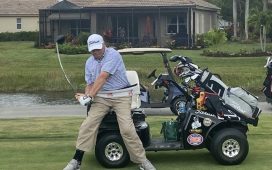MAMARONECK, N.Y. – One simple task needed to be completed before the membership at Winged Foot was ready to continue a collaboration with the United States Golf Association that dates back to 1929.
There was a fence to be mended.
While the West Course was back in play a week after the 2006 U.S. Open, the East Course remained in a state of limbo four months after Geoff Ogilvy watched Phil Mickelson, Jim Furyk and Colin Montgomerie stumble and claimed the championship.
It was a source of concern two years later when overtures were made to return to a venue that had hosted 11 previous USGA championships.
“We had a little bit of a falling out following 2006, such that we actually withdrew in 2015,” said Bryan Marsal, who is the U.S. Open chairman at Winged Foot.
Much of the infrastructure required to host a major championship was placed on the East Course, which happens to be a sentimental favorite of many longtime members. Complaints about the process of restoring the affected holes got louder and louder as the days got shorter and shorter.
“The USGA was always terrific about restoring the East Course to its original condition, but that was overshadowed by the inconvenience for the members,” said Marsal, who added that expectations originally communicated by Winged Foot’s leadership were not realistic given weather issues and the discovery of unexpected damage.
So when the USGA presented a proposal to Winged Foot in 2008, some of the members were reportedly unimpressed with the financial terms of the deal, but most of the dissent came from those who simply were not ready to deal with the hassle of another U.S. Open in 2015.
The longtime allies were unofficially on a break that lasted four years.
“We reconciled our differences by 2012 and signed a contract,” Marsal said. “From a Winged Foot perspective, there’s just no way, given the stewardship our members have, that we would not want to be a designated site for the national championship.”
The USGA agreed to be gentle.
“We understand our relationships with the host clubs have to be strong,” said Charlie Howe, who is the organization’s championship manager of the 120th U.S. Open. “We want to host championships on the best courses to showcase the best players in the world and we have to make sure we collaboratively address the construction timeline as well as the restoration period to get a golf course back to where it was. The golf course the championship is played on is well-protected with a rope line. It’s the ancillary space that needs to be taken care of, and at Winged Foot that ancillary space just happens to be another top-100 golf course. We’re really trying to be thoughtful about when we start construction and where we start construction.
“At the end of the day, we want to be invited back.”
So the footprint for the 2020 U.S. Open at Winged Foot has been scaled back. There is hope that more advance planning based off lessons learned will also limit the damage.
Recent fan surveys conducted by the USGA indicated overcrowding was becoming an issue, so U.S. Open ticket sales have been capped at lower numbers. That means there will be fewer literal footprints at Winged Foot this time around.
The pace of the breakdown will have to increase as the USGA agreed to have all structures off the premises 45 days after the championship, which is scheduled for June 18-21 of this year.
“And then we’ll start making decisions based on each area, deciding what we’re going to do, reseed or re-sod,” Winged Foot director of golf courses Steve Rabideau said. “It’s not great to re-sod in July or August so that might get pushed back to the fall.”
Fingers are no doubt crossed.
“There is a greater sensitivity,” Marsal said. “We’re spending a lot more time and effort on damage prevention in order to make sure the sacrifice the members are making is less than they were making in 2006 or 1984. I think we and the USGA have come to a pretty good understanding. We are working together more as partners than we did in the past. … We will get the East Course back in shape a lot faster and we will have a lot less destruction than we had in 2006 and hopefully that level will be satisfactory to the membership.”








